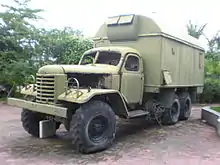Jiefang CA-30
The Jiefang CA-30 is a military truck used widely by the Chinese People's Liberation Army. It is a licensed-produced Soviet ZIL-157 and Hino TH-series 6x6 army truck, and looks similar to original, except that it has square fenders rather than round fenders as on the Soviet-produced ZIL-157.
| Jiefang CA30 | |
|---|---|
 Jiefang CA30 with radar van body in derelict condition | |
| Type | 2 1 1⁄2 ton 6x6 Cargo |
| Place of origin | China |
| Service history | |
| In service | From 1958 |
| Production history | |
| Manufacturer | FAW Jiefang aka JIEFANG |
| Produced | 1958–1986 |
| Specifications | |
| Mass | 11,770 lb (5,340 kg) |
| Length | 263 in (6.68 m) |
| Width | 91 in (2.31 m) |
| Height | 108 in (2.74 m) |
| Engine | Jiefang 120 336 cu in (5.5 L) gas I6 95 hp (71 kW) |
| Suspension | Wheel 6x6 |
| Maximum speed | 40 mph (64 km/h) |
History
Throughout the 1950s, the Soviet Army helped China to build up their heavy industries. As part of this plan, China established the First Automobile Works (FAW) in Changchun Northern China. Soon after, in July 1956, they introduced the Jiefang CA-10 4x2 army truck, a copy of the Russian or Japanese ZIS-150 Hino TH-series Models. In 1958-1959 the first 6X6 CA-30 lorries for the People's Republic of China army were introduced and made by the then called FAW Jiefang company.
[1] The FAW JIEFANG CA-30 its full name, like the Russian ZIL-157, had excellent cross-country capabilities and was available in a variety of configurations, such as cargo transport or tractor-trailer. Both the CA-10 and CA-30 were used extensively by the People's Liberation Army up until the 1990s, when they were largely phased out of service. Today, few remain in private hands. Later they specialized in off-road dump trucks and construction vehicles, most of these inspired by other Soviet designs. Iveco of Italy have since acquired the Jiefang Motor Vehicle Company. The manufacturer has since changed its name, now called FAW First Auto Works this company active since 1956.
In 1973 the firm designed and produced an allnew massive 60 Ton (when empty) original dumptruck model locally called the JIEFANG CA-390 much of it was inspired by former large Russian dumptrucks such as the largest models produced by BELAZ and MOAZ of the 1970s. The then large JIEFANG CA-390 was powered with a Chinese Chingfa C2956 V12 720 hp (540 kW) diesel engine that produced enough power to match several other similar dumptrucks at that time and its production was targeted as a quarry and mine vehicle, these are designed to carry 105 Tonnes of material when fully loaded so it became quite popular as the largest mining dumptruck available in China during the 1970s and 1980s. This was also the biggest original road vehicle ever made in China at that time until its production ended some time in the late 1970s of which some are still used as a cheap alternative mining dumptruck to run.[2] Later FAW JMC or also known as Jiefang Motor Company also manufactured under licence from the Mitsubishi Motors of Japan, the former original Japanese MITSUBISHI Fuso F-Series heavy lorry 1980s-1990s model range with some minor changes but powered by modern Chinese made running gear & mechanicals for the Asian/Oriental market and it is now one of China's most important and successful heavy vehicle manufacturers and JMC has cooperated and worked closely with Mitsubishi Heavy Industries or MHI of Japan ever since.
Specifications
- Seating (cab): 1+2
- Configuration: 6X6
- Weight (empty): 12,015.19 lb/5,450 kg
- Maximum Load: 9,920.8 lb/4,500 kg (on road), 5,511.56 lb/2,500 kg (cross-country)
- Length: 21.93 ft/6.684 m
- Width: 7.595 ft/2.315 m
- Height: 7.74 ft/2.36 m
- Wheel Base: N/A
- Track (front/rear): N/A
- Ground Clearance: N/A
- Top Speed (road): 40.39 mph/65 km/h
See also
References
- "Archived copy". Archived from the original on 2014-01-06. Retrieved 2014-01-05.CS1 maint: archived copy as title (link)
- "Archived copy". Archived from the original on 2014-01-06. Retrieved 2014-01-05.CS1 maint: archived copy as title (link)
- Ware, Pat (2010). The World Encyclopedia of Military Vehicles. Lorenz Books. p. 111. ISBN 0-7548-2052-1.